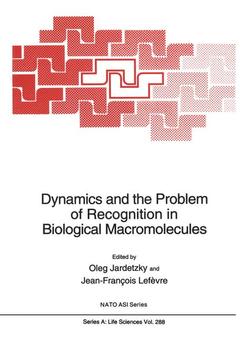Dynamics and the Problem of Recognition in Biological Macromolecules, 1996 NATO Science Series A: Series, Vol. 288
Langue : Anglais
Coordonnateurs : Jardetzky Oleg, Lefèvre Jean-François

From within complex structures of organisms and cells down to the molecular level, biological processes all involve movement. Muscular fibers slide on each other to activate the muscle, as polymerases do along nucleic acids for replicating and transcribing the genetic material. Cells move and organize themselves into organs by recognizing each other through macromolecular surface-specific interactions. These recognition processes involve the mu tual adaptation of structures that rely on their flexibility. All sorts of conformational changes occur in proteins involved in through-membrane signal transmission, showing another aspect of the flexibility of these macromolecules. The movement and flexibility are inscribed in the polymeric nature of essential biological macromolecules such as proteins and nucleic acids. For instance, the well-defined structures formed by the long protein chain are held together by weak noncovalent interac tions that design a complex potential well in which the protein floats, permanently fluctuating between several micro- or macroconformations in a wide range of frequencies and ampli tudes. The inherent mobility of biomolecular edifices may be crucial to the adaptation of their structures to particular functions. Progress in methods for investigating macromolecular structures and dynamics make this hypothesis not only attractive but more and more testable.
1. The Cooperative Substructure of Protein Molecules.- 2. NMR Structures of Serine Proteinase Inhibitors LDTI and RBI, and Comparison with X-Ray Structures.- 3. Solution Structure of the Long Neurotoxin LSIII with Possible Implications for Binding to the Acetylcholine Receptor.- 4. NMR Studies of Enzyme-Substrate and Protein-Protein Interactions.- 5. The Direct Determination of Protein Structure from Multidimensional NMR Spectra without Assignment: An Evaluation of the Concept.- 6. Accuracy of Nuclear Magnetic Resonance Derived Molecular Structures: Quantitative Uncertainty Analysis of Distance Constraints.- 7. What Limits Protein Folding.- 8. Approaches to the Determination of More Accurate Cross-Relaxation Rates and the Effects of Improved Distance Constraints on Protein Solution Structures.- 9. Protein Dynamics: From the Native to the Unfolded State and Back Again.- 10. Insights into Protein Dynamics by NMR Techniques.- 11. Heteronuclear Relaxation and the Experimental Determination of the Spectral Density Function.- 12. How Conventional Antigens and Superantigens Interact with the Human MHC Class II Molecule HLA-DR1.- 13. Simulating the Dynamics of the DNA Double Helix in Solution.- 14. Developments in NMR Structure Determination of Nucleic Acids.- 15. Solution Dynamics of the trp-Repressor Studied by NMR Spectroscopy.- 16. A Refined NMR Solution Structure of the POU-Specific Domain of the Human Oct-1 Protein.- 17. Applications of Multidimensional Solid-State NMR Spectroscopy to Membrane Proteins.- 18. Conformation, Mobility, and Function of the N-Linked Glycan in the Adhesion Domain of Human CD2.- Abstracts.- Participants Photos.- Author Index.
Date de parution : 10-2012
Ouvrage de 311 p.
17.8x25.4 cm
Thèmes de Dynamics and the Problem of Recognition in Biological... :
Mots-clés :
DNA; DNA double helix; cells; polymer; protein; proteins; spectroscopy
© 2024 LAVOISIER S.A.S.



